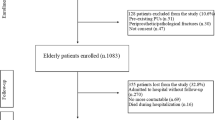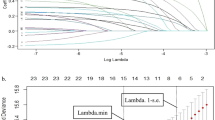Abstract
Background/objectives
Obesity is a global health challenge that affects a large proportion of adults worldwide. Obesity and frailty pose considerable health risks due to their potential to interact and amplify one another’s negative effects. Therefore, we sought to compare the discriminatory thresholds of the risk analysis index (RAI), 5-factor modified frailty index (m-FI-5) and patient age for the primary endpoint of postoperative mortality.
Subjects/methods
We included spine surgery patients ≥18 years old, from the American College of Surgeons National Quality Improvement program database from 2012-2020, that were classified as obese. We performed receiver operating characteristic curve analysis to compare the discrimination threshold of RAI, mFI-5, and patient age for postoperative mortality. Proportional hazards risk-adjusted regressions were performed, and Hazard ratios and corresponding 95% Confidence intervals (CI) are reported.
Results
Overall, there were 149 163 patients evaluated, and in the ROC analysis for postoperative mortality, RAI showed superior discrimination C-statistic 0.793 (95%CI: 0.773-0.813), compared to mFI-5 C-statistic 0.671 (95%CI 0.650–0.691), and patient age C-statistic 0.686 (95%CI 0.666-0.707). Risk-adjusted analyses were performed, and the RAI had a stepwise increasing effect size across frailty strata: typical patients HR 2.55 (95%CI 2.03-3.19), frail patients HR 3.48 (95%CI 2.49-4.86), and very frail patients HR 4.90 (95%CI 2.87–8.37). We found increasing postoperative mortality effect sizes within Clavein-Dindo complication strata, consistent across obesity categories, exponentially increasing with frailty, and multiplicatively enhanced within CD, frailty and obesity strata.
Conclusion
In this study of 149 163 patients classified as obese and undergoing spine procedures in an international prospective surgical database, the RAI demonstrated superior discrimination compared to the mFI-5 and patient age in predicting postoperative mortality risk. The deleterious effects of frailty and obesity were synergistic as their combined effect predicted worse outcomes.
This is a preview of subscription content, access via your institution
Access options
Subscribe to this journal
Receive 12 print issues and online access
$259.00 per year
only $21.58 per issue
Buy this article
- Purchase on Springer Link
- Instant access to full article PDF
Prices may be subject to local taxes which are calculated during checkout


Similar content being viewed by others
Data availability
The data utilized in this study is publicly available and can be accessed by researchers upon request. Detailed information about the dataset, including access requirements and procedures, can be found on the ACS website. Data sharing adheres to the guidelines and policies set forth by the data provider.
References
WHO. Obesity and overweight. 2023 https://www.who.int/news-room/fact-sheets/detail/obesity-and-overweight. Accessed 8 Feb 2023.
Bhupathiraju SN, Hu FB. Epidemiology of obesity and diabetes and their cardiovascular complications circulation research. 2023 https://www.ahajournals.org/doi/full/10.1161/CIRCRESAHA.115.306825. Accessed 8 Feb 2023.
NCD Risk Factor Collaboration (NCD-RisC)Worldwide trends in body-mass index, underweight, overweight, and obesity from 1975 to 2016: a pooled analysis of 2416 population-based measurement studies in 128·9 million children, adolescents, and adults. Lancet Lond Engl. 2017;390:2627–42.
Swinburn BA, Sacks G, Hall KD, McPherson K, Finegood DT, Moodie ML, et al. The global obesity pandemic: shaped by global drivers and local environments. Lancet Lond Engl. 2011;378:804–14.
Bray GA, Heisel WE, Afshin A, Jensen MD, Dietz WH, Long M, et al. The science of obesity management: an endocrine society scientific statement. Endocr Rev. 2018;39:79–132.
Lang LH, Parekh K, Tsui BYK, Maze M. Perioperative management of the obese surgical patient. Br Med Bull. 2017;124:135–55.
Bluth T, Pelosi P, de Abreu MG. The obese patient undergoing nonbariatric surgery. Curr Opin Anaesthesiol. 2016;29:421–9.
Jiang J, Teng Y, Fan Z, Khan S, Xia Y. Does obesity affect the surgical outcome and complication rates of spinal surgery? A meta-analysis. Clin Orthop. 2014;472:968–75.
Maradit Kremers H, Visscher SL, Kremers WK, Naessens JM, Lewallen DG. Obesity Increases Length of Stay and Direct Medical Costs in Total Hip Arthroplasty. Clin Orthop Relat Res. 2014;472:1232–9.
Terada T, Johnson JA, Norris C, Padwal R, Qiu W, Sharma AM, et al. Severe obesity is associated with increased risk of early complications and extended length of stay following coronary artery bypass grafting surgery. J Am Heart Assoc. 2020;5:e003282.
Porter Starr KN, McDonald SR, Bales CW. Obesity and physical frailty in older adults: a scoping review of lifestyle intervention trials. J Am Med Dir Assoc. 2014;15:240–50.
He D, Qiu Y, Yan M, Zhou T, Cheng Z, Li J, et al. Associations of metabolic heterogeneity of obesity with frailty progression: Results from two prospective cohorts. J Cachexia Sarcopenia Muscle. 2023;14:632–41.
Fried LP, Tangen CM, Walston J, Newman AB, Hirsch C, Gottdiener J, et al. Frailty in older adults: evidence for a phenotype. J Gerontol A Biol Sci Med Sci. 2001;56:M146–156.
Rockwood K, Song X, MacKnight C, Bergman H, Hogan DB, McDowell I, et al. A global clinical measure of fitness and frailty in elderly people. CMAJ Can Med Assoc J J Assoc Med Can. 2005;173:489–95.
Goeddel LA, Murphy Z, Owodunni O, Esfandiary T, Campbell D, Shay J, et al. Domains of frailty predict loss of independence in older adults after noncardiac surgery. Ann Surg. 2023;278:e226.
Owodunni OP, Yocky AG, Courville EN, Peter–Okaka U, Alare KP, Schmidt M, et al. A comprehensive analysis of the triad of frailty, aging, and obesity in spine surgery: the risk analysis index predicted 30–day mortality with superior discrimination. Spine J. 2023;55:5623.
Villareal DT, Apovian CM, Kushner RF, Klein S. American Society for Nutrition, NAASO, The Obesity Society. Obesity in older adults: technical review and position statement of the American Society for Nutrition and NAASO, The Obesity Society. Am J Clin Nutr. 2005;82:923–34.
Berg AH, Scherer PE. Adipose tissue, inflammation, and cardiovascular disease. Circ Res. 2005;96:939–49.
Ehrlich AL, Owodunni OP, Mostales JC, Qin CX, Hadvani PJ, Sirisegaram L, et al. Early outcomes following implementation of a multispecialty geriatric surgery pathway. Ann Surg. 2023;277:e1254–61.
Ehrlich AL, Owodunni OP, Mostales JC, Efron J, Hundt J, Magnuson T, et al. Implementation of a multi-specialty geriatric surgery pathway reduces inpatient cost for frail patients. Ann Surg. 2023;554:e6521.
Hampton JP, Owodunni OP, Bettick D, Chen SY, Sateri S, Magnuson T, et al. Compliance to an enhanced recovery pathway among patients with a high frailty index after major gastrointestinal surgery results in improved 30-day outcomes. Surgery. 2019;166:75–81.
Subramaniam S, Aalberg JJ, Soriano RP, Divino CM. New 5-factor modified frailty index using American College of Surgeons NSQIP data. J Am Coll Surg. 2018;226:173–181.e8.
Arya S, Varley P, Youk A, Borrebach J, Perez S, Massarweh NN, et al. Recalibration and external validation of the risk analysis index: a surgical frailty assessment tool. Ann Surg. 2020;272:996–1005.
Hall DE, Arya S, Schmid KK, Blaser C, Carlson MA, Bailey TL, et al. Development and initial validation of the risk analysis index for measuring frailty in surgical populations. JAMA Surg. 2017;152:175–82.
Owodunni OP, Uzoukwu C, Courville EN, Schmidt MH, Bowers CA. The fine line between simplicity and oversimplification: comparing the risk analysis index and 5-factor modified frailty index as frailty assessment tools. Neurospine. 2023;20:728–30.
Dindo D, Demartines N, Clavien PA. Classification of surgical complications: a new proposal with evaluation in a Cohort of 6336 patients and results of a survey. Ann Surg. 2004;240:205.
Ghaferi AA, Osborne NH, Birkmeyer JD, Dimick JB. Hospital characteristics associated with failure to rescue from complications after pancreatectomy. J Am Coll Surg. 2010;211:325.
Owodunni OP, Bowers CA. Letter: beyond risk assessment: a new vision for transdisciplinary frailty care coordination in neurosurgery. Neurosurgery. 2022. https://doi.org/10.1227/neu.0000000000002651.
Ades PA, Savage PD. The obesity paradox: perception vs knowledge. Mayo Clin Proc. 2010;85:112–4.
Uretsky S, Messerli FH, Bangalore S, Champion A, Cooper-Dehoff RM, Zhou Q, et al. Obesity paradox in patients with hypertension and coronary artery disease. Am J Med. 2007;120:863–70.
Galal W, van Gestel YRBM, Hoeks SE, Sin DD, Winkel TA, Bax JJ, et al. The obesity paradox in patients with peripheral arterial disease. Chest. 2008;134:925–30.
Romero-Corral A, Montori VM, Somers VK, Korinek J, Thomas RJ, Allison TG, et al. Association of bodyweight with total mortality and with cardiovascular events in coronary artery disease: a systematic review of cohort studies. Lancet Lond Engl. 2006;368:666–78.
Hainer V, Aldhoon-Hainerová I. Obesity paradox does exist. Diabetes Care. 2013;36:S276–81.
Mei X, Hu S, Mi L, Zhou Y, Chen T. Body mass index and all-cause mortality in patients with percutaneous coronary intervention: a dose–response meta-analysis of obesity paradox. Obes Rev. 2021;22:e13107.
Villareal DT, Banks M, Siener C, Sinacore DR, Klein S. Physical frailty and body composition in obese elderly men and women. Obes Res. 2004;12:913–20.
Knutsson B, Michaëlsson K, Sandén B. Obesity is associated with inferior results after surgery for Lumbar Spinal Stenosis: a study of 2633 patients from the Swedish spine register. Spine. 2013;38:435.
Lee Y, Kim J, Han ES, Ryu M, Cho Y, Chae S. Frailty and body mass index as predictors of 3-year mortality in older adults living in the community. Gerontology. 2014;60:475–82.
Chan GCK, G JKCN, Chow KM, Kwong VWK, Pang WF, Cheng PMS, et al. Interaction between central obesity and frailty on the clinical outcome of peritoneal dialysis patients. PLoS One. 2020;15:e0241242.
Huschak G, Busch T, Kaisers UX. Obesity in anesthesia and intensive care. Best Pract Res Clin Endocrinol Metab. 2013;27:247–60.
Na BG, Park SJ. Perioperative management of morbidly obese patients during major abdominal surgery. Ann Clin Nutr Metab. 2021;13:26–33.
Yocky AG, Owodunni OP, Courville EN, Kazim SF, Schmidt MH, Gearhart SL, et al. The risk analysis index has superior discrimination compared with the modified frailty index-5 in predicting worse postoperative outcomes for the octogenarian neurosurgical patient. Neurosurg Pract. 2023;4:e00044.
Owodunni OP, Roster K, Varela S, Kazim SF, Okakpu U, Tarawneh OH, et al. Preoperative frailty risk in deep brain stimulation patients: risk analysis index predicts Clavien-Dindo IV complications. Clin Neurol Neurosurg. 2023;226:107616.
Roster K, Moya A, Owodunni OP, Courville EN, Schmidt M, Bowers CA, et al. A cautionary tale: frailty predicts mortality after deep brain stimulation and the risk analysis index has an unparalleled classification threshold. J Neurosurg Sci. 2023;89:254–322.
Owodunni OP, Peter-Okaka U, Courville EN, Schmidt MH, Bowers CA. Letter: A pathway to safe spine surgery in underweight frail patients: the revised risk analysis index displays remarkable discrimination for 30-day postoperative mortality and nonhome discharge. Neurosurgery. 2023;93:e42.
Acknowledgements
The STROBE (Strengthening the Reporting of Observational Studies in Epidemiology) reporting requirements were strictly adhered for this observational study.
Author information
Authors and Affiliations
Contributions
OPO: conceptual design, validation, methodology, formal analysis, visualization, writing initial draft, data curation, project administration. CAB: supervision, data acquisition. ENC, UP-O, CBR, MHS, and CAB: critical review, editing. All authors read and approved the final version of the manuscript All individuals listed as authors confirm their significant contributions to the publication, including concept, design, analysis, writing, or revision, and they accept public responsibility for the content.
Corresponding author
Ethics declarations
Competing interests
The authors declare no competing interests.
Ethics
This study adhered to the ethical requirements of the institutional and national research committees, as well as the Helsinki Declaration of 1964 and its updates or similar ethical standards. The University of New Mexico’s Institutional Review Board approved this study, and the research was conducted according to the ACS-NSQIP’s data user agreement guidelines.
Additional information
Publisher’s note Springer Nature remains neutral with regard to jurisdictional claims in published maps and institutional affiliations.
Supplementary information
Rights and permissions
Springer Nature or its licensor (e.g. a society or other partner) holds exclusive rights to this article under a publishing agreement with the author(s) or other rightsholder(s); author self-archiving of the accepted manuscript version of this article is solely governed by the terms of such publishing agreement and applicable law.
About this article
Cite this article
Owodunni, O.P., Courville, E.N., Peter-Okaka, U. et al. Multiplicative effect of frailty and obesity on postoperative mortality following spine surgery: a deep dive into the frailty, obesity, and Clavien-Dindo dynamic. Int J Obes 48, 360–369 (2024). https://doi.org/10.1038/s41366-023-01423-0
Received:
Revised:
Accepted:
Published:
Issue Date:
DOI: https://doi.org/10.1038/s41366-023-01423-0



